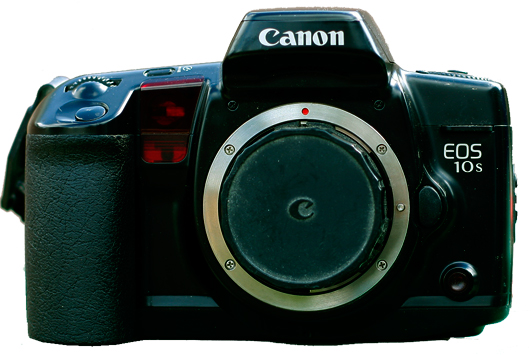
Lens Mount: Canon EF (autofocus)
AKA: EOS 10 QD (Asia), EOS 10 (Europe)
Battery: 2CR5
Approx. date of manufacture: 1990
Approx. street value: $10
This was a killer when it came out. It was the #2 camera on Canon's heirarchy, just below the EOS-1. Even so, Canon (then and now) often introduced new technology and features on their lesser models; the top-tier professional cameras got them when they were battle-proven.
The late, great Herb Keppler wrote the "SLR Notebook" column for decades in camera magazines. Often he got preproduction cameras that were about to be released and was able to write them up. Here's the beginning of his article on the 10s, which appeared in Popular Photography, April 1990 (p.20):
"The EOS 10S is instended to have the highest-performance autofocus sytem of any camera on the market," explained the Canon tech rep. "It is truly the first camera in a new generation of autofocus EOS cameras," he added, handing us the preproduction sample.
. . . "The camera uses a multiple-point autofocus detector with three viewfinder positions," continued the tech rep. "We've come up with a multiple-point based sensor that actually covers three individual picture-area zones. Of course, this has been done before [meaning the Minolta 7000i—Ed.]. But we've tried to make it a whole lot more effective."
In addition to the advanced focus system, which ended up as the basis for subsequent EOS cameras, the camera has a lot of other features: a number of exposure program modes, a built-in wireless remote control, built-in date & time imprinting, and a built-in interval-lapse timer (most cameras needed an accessory back to add these features). It has a pop-up flash with a disabled automatic feature in the USA market, due to patent license conflicts; in Asia and Europe the auto-pop-up works.
Most people who discuss this camera mention one of the unusual features it has: an ability to take an accessory barcode reader that can be used to add more program modes to the camera; you get a booklet of program settings in barcode format, scan the one you want and upload it to the camera. There was thought that if it was popular, user-made barcode capability would be offered, but as far as I know that never happened.
The feature that I think is interesting, yet never see mentioned, is the "ISP" mode. On the exposure-program dial (top left-hand side), right under the M manual setting, there's an icon of a camera with little motion lines on either side of it. If you choose that mode, the camera evaluates your steadiness and warns you that the shutter speed is too slow for your exposure setting. It's a feature that disappeared on later cameras, so I don't know if it didn't work well or if people just didn't like it, but I think it's pretty slick.
It's also light. The body is polycarbonate/fiberglass except for the lens mount itself, which is still metal.
I haven't tried it out and probably never will. As a failry early EOS camera, it's much less capable than my Elan IIe or even the later Rebels, but it's still a pretty damn nice camera body.
For more information: Canon Camera Museum
Popular Photography magazine camera test: February 1991
Popular Photography magazine preview: April 1990
Camera manual: Orphan Cameras.com



